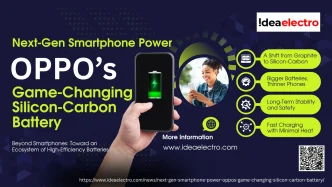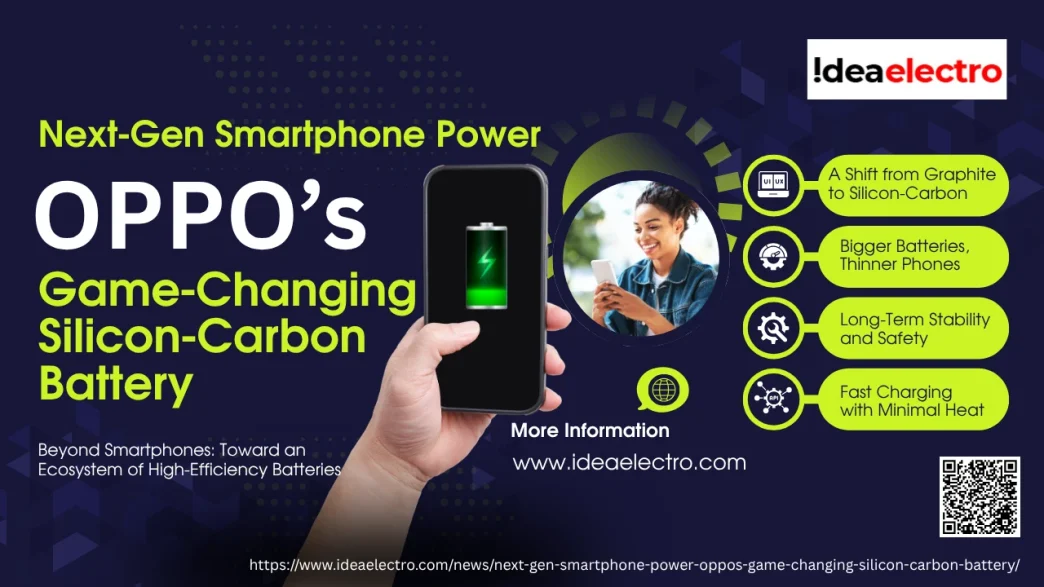In a significant leap forward for mobile technology, OPPO has unveiled its latest innovation: silicon-carbon battery technology, a powerful advancement poised to redefine how smartphones handle energy efficiency, fast charging, and form factor. First introduced in the flagship OPPO Find X8 series and now expanding across premium models like the OPPO Find N5 foldable, this breakthrough marks a major step in smartphone battery evolution.
1. A Shift from Graphite to Silicon-Carbon
Unlike traditional lithium-ion batteries that use graphite anodes, OPPO’s new batteries incorporate a silicon-carbon composite anode, enhancing energy density by up to 20% compared to conventional cells. Silicon, capable of holding significantly more charge per gram than graphite, has historically been limited by expansion issues. OPPO engineers have reportedly solved this by combining silicon with a carbon matrix, minimizing structural degradation while maintaining conductivity.
2. Bigger Batteries, Thinner Phones
The OPPO Find X8 Pro showcases the benefits of the new battery, housing a 5,910mAh cell in a chassis only 8.24 mm thick—an engineering feat that balances capacity and sleek design. The standard Find X8 includes a 5,630mAh battery in a 7.85 mm frame, offering over 26 hours of continuous video playback, according to OPPO’s internal tests. This innovation reduces battery thickness from 5.87 mm to just 5.1 mm, thanks to high-strength copper foil, a laser-drilled cell structure, and the silicon-carbon anode’s reduced volume footprint.
3. Fast Charging with Minimal Heat
Despite the slim profiles, OPPO hasn’t compromised on charging speed. The new battery architecture supports 80W SUPERVOOC wired charging and 50W AirVOOC wireless charging. Advanced thermal controls—including a nano-crystal-based air charging coil just 0.18 mm thick—keep temperatures below 41°C, even during peak charging.
4. Long-Term Stability and Safety
To manage silicon’s natural expansion during charge cycles, OPPO’s engineers incorporated smart algorithms and a stabilizing carbon lattice. According to OPPO, the result is a battery that can maintain over 1,000 charging cycles with minimal capacity loss—on par with traditional lithium-ion solutions but with significantly higher energy density. In addition, the silicon-carbon battery offers better thermal regulation, faster charging, and improved structural durability, making it ideal for both everyday smartphones and more demanding foldable form factors.
5. Beyond Smartphones: Toward an Ecosystem of High-Efficiency Batteries
OPPO is reportedly developing even higher-capacity versions of this technology. Internal sources suggest work is underway on 8,000mAh silicon-carbon batteries with 80W charging support. These could appear in future foldables or tablets. The company has also partnered with OnePlus and CATL to scale the production of silicon-carbon cells, indicating a long-term roadmap beyond a single product cycle.
6. Environmentally Friendly, Future-Ready
Beyond performance gains, OPPO emphasizes the environmental benefits of the new battery. Silicon-carbon batteries reportedly generate a lower carbon footprint during production and extend device longevity, reducing e-waste over time. Unlike many next-gen solutions that remain theoretical, OPPO’s batteries are already in-market, signaling a transition from lab to large-scale deployment.
7. Industry-Wide Implications
The introduction of silicon-carbon battery tech comes as other smartphone giants—like Vivo, Honor, and Xiaomi—also explore similar solutions. Industry experts believe OPPO’s real-world deployment will pressure rivals to accelerate battery innovation. “Silicon-carbon batteries represent one of the most impactful developments in mobile hardware this decade,” said Dr. Li Chen, a materials science professor at Tsinghua University. “If scaled efficiently, this could render traditional lithium-ion solutions obsolete in premium segments.”
8. Challenges Remain
Despite its promise, the technology faces challenges. Manufacturing silicon-carbon batteries is more complex and expensive, requiring precision in anode fabrication and expansion control. For now, OPPO’s use is limited to flagship models, but executives suggest a phased rollout across more devices in 2026.
A New Standard in Smartphone Power
As OPPO continues to refine the technology, the silicon-carbon battery marks a tangible step forward in smartphone engineering. Users can now enjoy longer battery life, faster charging, and slimmer designs—all without compromise.
With consumer expectations rising and mobile devices doing more than ever, OPPO’s battery innovation doesn’t just keep up—it sets the pace.
Source: OPPO Global Communications www.oppo.com



